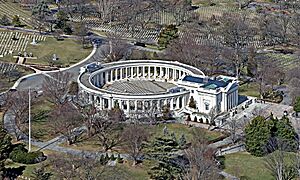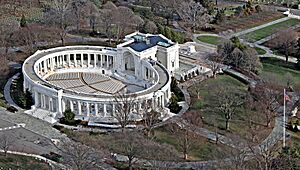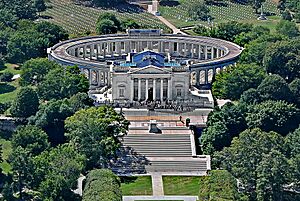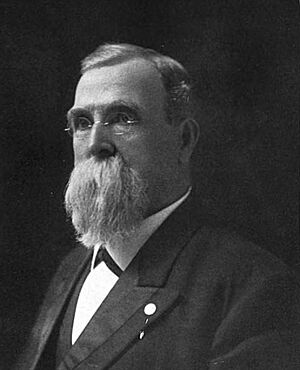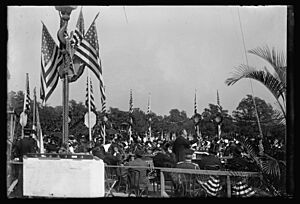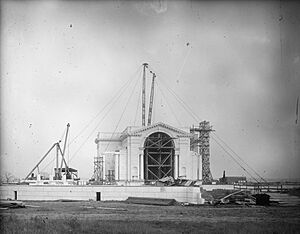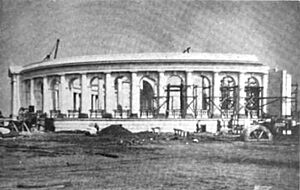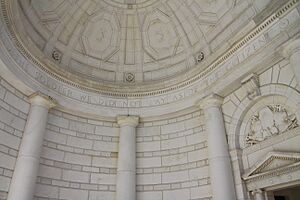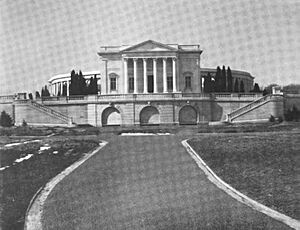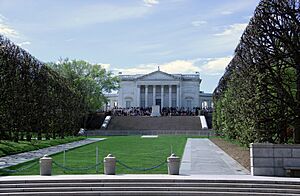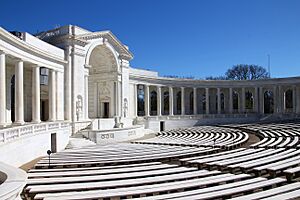Arlington Memorial Amphitheater facts for kids
Quick facts for kids Memorial Amphitheater |
|
|---|---|

Aerial view looking southeast at Memorial Amphitheater
|
|
| Location | Arlington County, Virginia |
| Established | May 15, 1920 |
| Governing body | U.S. Department of the Army |
| Lua error in Module:Location_map at line 420: attempt to index field 'wikibase' (a nil value). | |
The Memorial Amphitheater is a special outdoor theater, a display hall, and a chapel in Arlington National Cemetery in Arlington, Virginia. It was built to replace an older, wooden theater. Construction started in March 1915, and it was officially opened in May 1920.
Right in front of its eastern steps is the Tomb of the Unknown Soldier, which was dedicated in 1921. This important place is used for many Veterans Day and Memorial Day events. It also hosts memorial services and funerals for many people.
Contents
Why Was the Amphitheater Built?
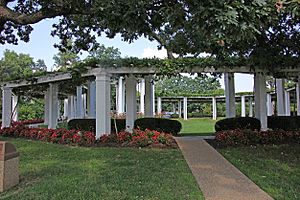
Arlington National Cemetery was created in 1864. As the cemetery became more important, more people came to events like Memorial Day. Because of this, Brigadier General Montgomery C. Meigs decided a proper meeting place was needed. An older, wooden theater was built in 1873, but it soon became too small.
By the early 1900s, the Old Amphitheater was much too small for the large ceremonies held there. A judge named Ivory Kimball believed a new, bigger place was needed. He also thought this new amphitheater should honor soldiers from all wars, not just the American Civil War.
Kimball and a veterans' group called the Grand Army of the Republic (GAR) started pushing for a new amphitheater in 1903. Sketches were drawn by Frederick D. Owen, an engineer. However, laws to fund the project failed in Congress several times.
Finally, in 1912, Senator George Sutherland introduced a bill. It suggested building a 5,000-seat amphitheater with an underground crypt for important people. This would cost no more than $750,000. With other new memorials being approved, the bill passed. President William Howard Taft signed it into law on March 4, 1913.
A special group, the Arlington Memorial Amphitheater Commission (AMAC), was set up to manage the design and building. Its members included the Secretary of War, the Secretary of the Navy, and Judge Kimball.
At first, Congress approved the money but didn't actually provide it. So, the AMAC had no funds. It wasn't until August 1, 1914, that Congress finally gave the money. Ten days later, Colonel William W. Harts became the commission's executive director. In October 1914, the AMAC hired the architectural firm of Carrère and Hastings to design the building. The George A. Fuller Co. was hired to build it in February 1915.
There is some debate about who deserves the most credit for the design. Some sources say Thomas Hastings was the main designer. Others point to Frederick D. Owen, who drew the first sketches in 1904 and gave many ideas. The AMAC itself noted Owen's important role, but also said Carrère and Hastings prepared the final plans.
Building the Memorial Amphitheater
The new Memorial Amphitheater was built on top of a hill about 1,000 feet (300 m) south of Arlington House. There used to be a gravel pit there.
Construction began on March 1, 1915. President Woodrow Wilson laid the cornerstone in a ceremony on October 13, 1915. A copper box was placed inside the cornerstone. It held important items like a copy of the United States Constitution, the Bible, the flag of the United States, and coins. Judge Kimball was there for these ceremonies, but he passed away in May 1916 before the amphitheater was finished.
By June 1915, the foundation was mostly complete. It used 629,000 bricks and a lot of marble for the outside. The Guastavino tile system was used for arches in the basement.
A big change happened in June 1915. Originally, the plans called for wood and plaster. But these materials were changed to marble, which cost an extra $41,000.
Work slowed down in 1916 and 1917 because it was hard to get high-quality marble. Bad winter weather also caused delays. The project was supposed to be finished by February 1917, but it was delayed for a full year. It also cost more than expected.
By June 1917, much of the amphitheater and its columns were done. More marble, concrete, and steel were used. Skylights and stairs were put in place, and carving began.
The amphitheater, chapel, and most of the entrance hall were finished in 1918. The entrance hall used red brick and was covered in marble. The inside was decorated with plaster, tile, and bronze.
World War I affected the construction. Many skilled workers went to war. It was also hard to transport marble because trains and ships were busy with war supplies. This caused more delays. Some changes were made to the design, like removing planned seating on top of the colonnade.
By June 1918, almost all of the outside of the Memorial Amphitheater was complete. The inside of the chapel and reception hall were also done.
Interior work finished in June 1919. The remaining rooms and the second floor were completed. All that was left was decorating the chapel ceiling, adding inscriptions, and installing lights. The grounds were also prepared with roads, sidewalks, and plants. The total cost was $810,812. About 87,000 cubic feet (2,460 m³) of marble from Vermont were used.
The Memorial Amphitheater was officially opened on May 15, 1920. The Corps of Engineers handed it over to the Quartermaster General's office on July 1.
Amphitheater Design and Features
Thomas Hastings designed the Memorial Amphitheater to be the center of several monuments and gardens. It uses elements from ancient Greek, Roman, and Renaissance styles. Ulysses Ricci designed the carvings and decorations. Hastings hoped this building would be what he was most remembered for.
The outdoor amphitheater can seat 4,000 people. The areas around the columns can seat another 150. About 1,000 more people can stand.
A row of columns, called a colonnade, surrounds the amphitheater. The main entrances are on the east and west sides. The columns have Doric tops but Attic bases. Above the columns, there are inscriptions listing 44 major battles from the American Revolutionary War through the Spanish–American War.
Inside, low marble benches are arranged in circles facing the stage. The stage has three levels. On the lowest level is a klismos, an ancient Greek chair for rulers. This chair faces the audience, reminding them of the heroes the amphitheater honors. The second level has a podium for speakers. The stage is designed so speakers look down at the klismos chair and up at the USS Maine Mast Memorial. The top level of the stage has seating for about 100 people and a curved back wall called an apse.
The inside of the apse dome is beautifully carved. Square pillars on either side of the stage list the names of famous American generals (on the left) and admirals (on the right) from the American Revolutionary War through the Spanish–American War.
A quote from George Washington is carved inside the apse. It says, "When we assumed the soldier we did not lay aside the citizen." This means that even as soldiers, they were still citizens.
A quote from President Abraham Lincoln's Gettysburg Address is carved above the stage: "We here highly resolve that these dead shall not have died in vain."
Tall, decorative urns carved with eagles, rams' heads, and snakes are placed on pedestals on either side of the stage.
Above the west entrance, there is a quote from the Roman poet Horace: "Dulce et decorum est pro patria mori" ("It is sweet and fitting to die for one's country"). Under the colonnade, there are 300 crypts, which were meant for burying important people.
In the basement, beneath the amphitheater stage, is a chapel. This domed room can seat 150 people.
The main entrance is on the east side through a cross-shaped entrance hall. This hall has a front porch with six columns. Above the main bronze doors, there are carvings showing symbols of war. The entrance hall is not directly connected to the amphitheater inside. Stairs and corridors outside connect them. The main floor of the reception hall is covered in marble. It used to be a reception hall with two side areas for displaying battle flags. The second floor was a museum. In 1929, the main floor became a Memorial Exhibit Hall, showing honors received by the unknown soldiers. The second floor became offices.
Steps lead from the entrance hall down to a small open area. Hastings designed more steps to lead down to a formal garden. A pedestal for a statue was planned in the middle of these steps, but no statue was ever placed there. This pedestal was later removed, and the Tomb of the Unknown Soldier was built there in 1921. The large steps to the garden were not built at first; a retaining wall was put in instead.
History and Changes
Building the Tomb of the Unknown Soldier
On March 4, 1921, Congress approved building a memorial for an unidentified American soldier from World War I. This memorial would be placed in the steps leading up to the amphitheater. An unknown soldier was brought from France and buried in a small marble tomb on Armistice Day, November 11, 1921.
To build the Tomb of the Unknown Soldier, the planned pedestal for the statue was removed. Workers dug 20 feet (6 m) down. Concrete foundations were built, and the walls were reinforced with thick concrete. A hollow stone base was built on top of the vault. Soil from France was placed at the bottom of the vault. After the unknown soldier was lowered, the tomb was sealed.
More changes were made to the east front a few years later. In 1926, Congress approved finishing the Tomb of the Unknown Soldier with a proper memorial. A design by architect Lorimer Rich and sculptor Thomas Hudson Jones was chosen in 1928. This design suggested removing the retaining wall and building the monumental staircase that Thomas Hastings had first imagined. Congress agreed, and in 1929, they approved building the stairs, new roads, and changes to the gardens.
Later Renovations and Expansions
Not much work was done until 1954. By then, the amphitheater and entrance hall were settling, walls were cracking, and there was water damage. A study found that repairs would cost a lot of money, mainly because the original design didn't account for the marble expanding and shrinking with the weather. Congress approved funds for repairs.
A second major change happened in 1958. President Dwight Eisenhower signed a law in 1956 to allow unidentified soldiers from World War II and the Korean War to be buried at the Tomb of the Unknowns. Two new burial vaults were dug in the plaza. The Korean War unknown was buried in the northwest vault, and the World War II unknown was buried in the southwest vault. Both were interred on Memorial Day, May 30, 1958.
In 1960, Congress ended the Arlington Memorial Amphitheater Commission and gave its duties to the Secretary of Defense.
In 1964, a ceremony celebrated the 100th anniversary of Arlington National Cemetery. In 1969, the American Legion donated an outdoor lighting system so the amphitheater and Tomb of the Unknowns could be lit at night.
1974 and 1995 Renovations
More problems appeared in 1965, with cracks in the retaining walls and the Tomb of the Unknowns. Congress provided funds in 1972 to fix these issues and renovate the exhibit hall. Because more people were visiting the cemetery, Congress also funded widening the walkways to handle larger crowds. To make the amphitheater easier for people with disabilities, steep slopes were removed and steps were replaced with ramps. More funds were added in 1974, bringing the total to $4 million. This paid for widening the steps and entrance to allow 800 people (up from 200) to view the changing of the guard.
In 1977, there was an attempt to dedicate the chapel to Vietnam War veterans. However, it was decided that if the chapel were dedicated, it should be to all veterans. So, the chapel remained unnamed.
On Veterans Day in 1978, President Jimmy Carter dedicated a plaque inside the exhibit hall honoring Vietnam War veterans. In 1983, two temporary plaques were dedicated, one for Vietnam War personnel and another explaining why no Vietnam War unknown had been interred yet.
Major renovations happened in the mid-1990s to fix rainwater damage and leaks. This included installing new waterproof layers, cleaning stains, repairing marble, and replacing old railings and benches. New wheelchair ramps were also added.
A controversy arose in 2011 when original decorative urns from the 1995-1996 renovation appeared at an auction. These 9-foot (2.7 m) tall urns, sculpted by Ulysses Ricci, used to stand on either side of the stage. They were supposed to be preserved or put in a museum, not sold. After news reports, the U.S. Army asked the auction house to stop the sale. On January 24, 2011, the urns were returned to Arlington National Cemetery.
Recent Changes
In 1999, moisture damaged the chapel ceiling. Also in 1999, the plaza of Memorial Amphitheater was changed again. An unidentified Vietnam War servicemember had been buried in the Tomb of the Unknowns in 1984. However, questions arose in 1994 that suggested the remains could be identified. After testing, it was confirmed in 1998 that the remains belonged to United States Air Force 1st Lieutenant Michael Blassie. On September 16, 1999, the marble slab over the now-empty burial vault was replaced with a new one. The new slab says, "Honoring and Keeping Faith with America's Missing Servicemen."
By 2000, the east entrance hall had more water damage. Repairs were made in 2006 to fix leaks and improve drainage.
In 2012, more repairs were made to the walkways around the amphitheater. About 230,000 square feet (21,368 m²) of flagstone walkway were replaced.
Famous Events and Funerals

The Memorial Amphitheater has hosted many Memorial Day and Veterans Day ceremonies. Every American President since 1921, except Woodrow Wilson, has visited the building. President Warren G. Harding was the first sitting president to visit in May 1921 and the first to speak there in May 1923.
Many famous Americans have had their funerals at the amphitheater. The first funeral was for sculptor Moses Jacob Ezekiel in 1921. Other notable funerals include those for General John J. Pershing, General Henry H. Arnold, and explorer Richard E. Byrd. In 2002, a service was held for the unidentified victims of the September 11 attacks on The Pentagon.
Frank Buckles, the last American veteran of World War I, lay in state in the Memorial Amphitheater Chapel in 2011.
An Easter sunrise service has been held at Memorial Amphitheater every year since 1931. The first service was organized by the Knights Templar and included music from the United States Marine Band. President Herbert Hoover attended. This service, along with Memorial Day and Veterans Day ceremonies, is one of the most popular annual events at the amphitheater.
See also
- List of contemporary amphitheatres


